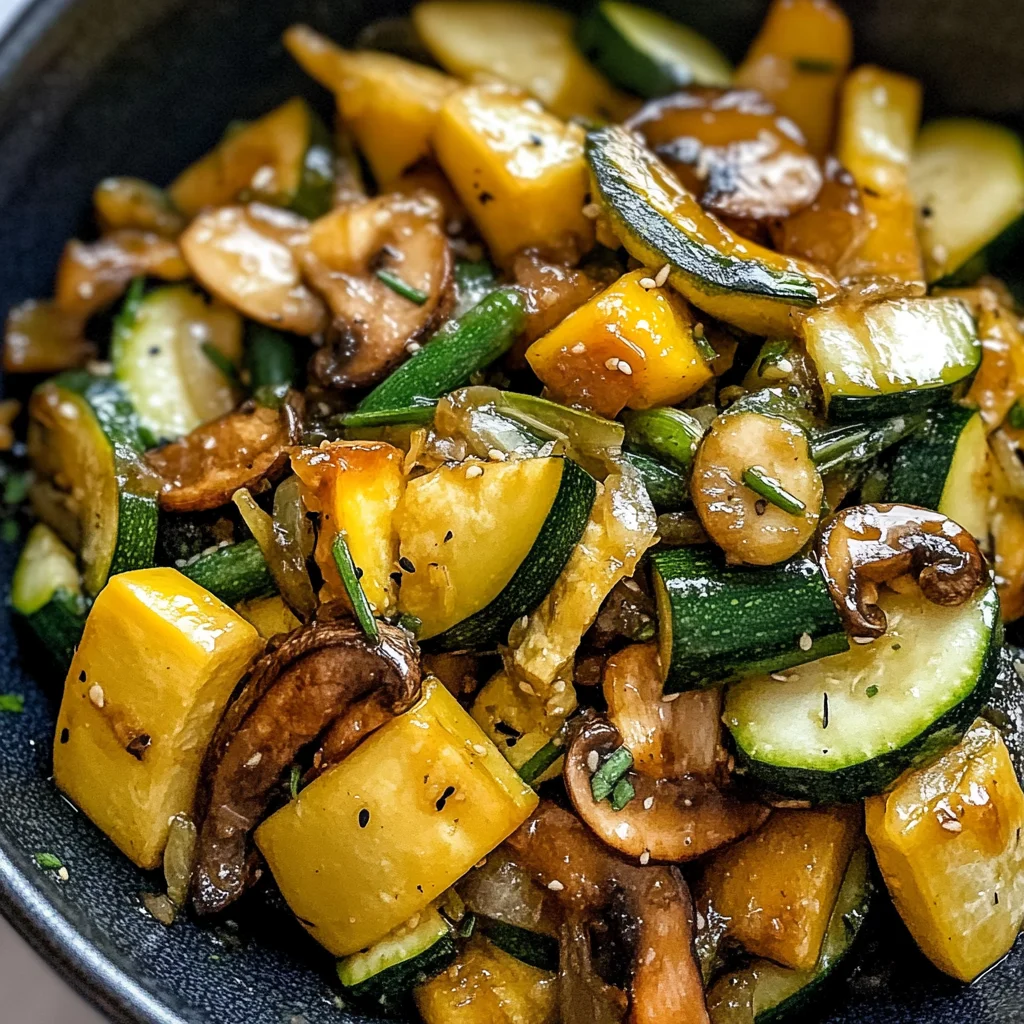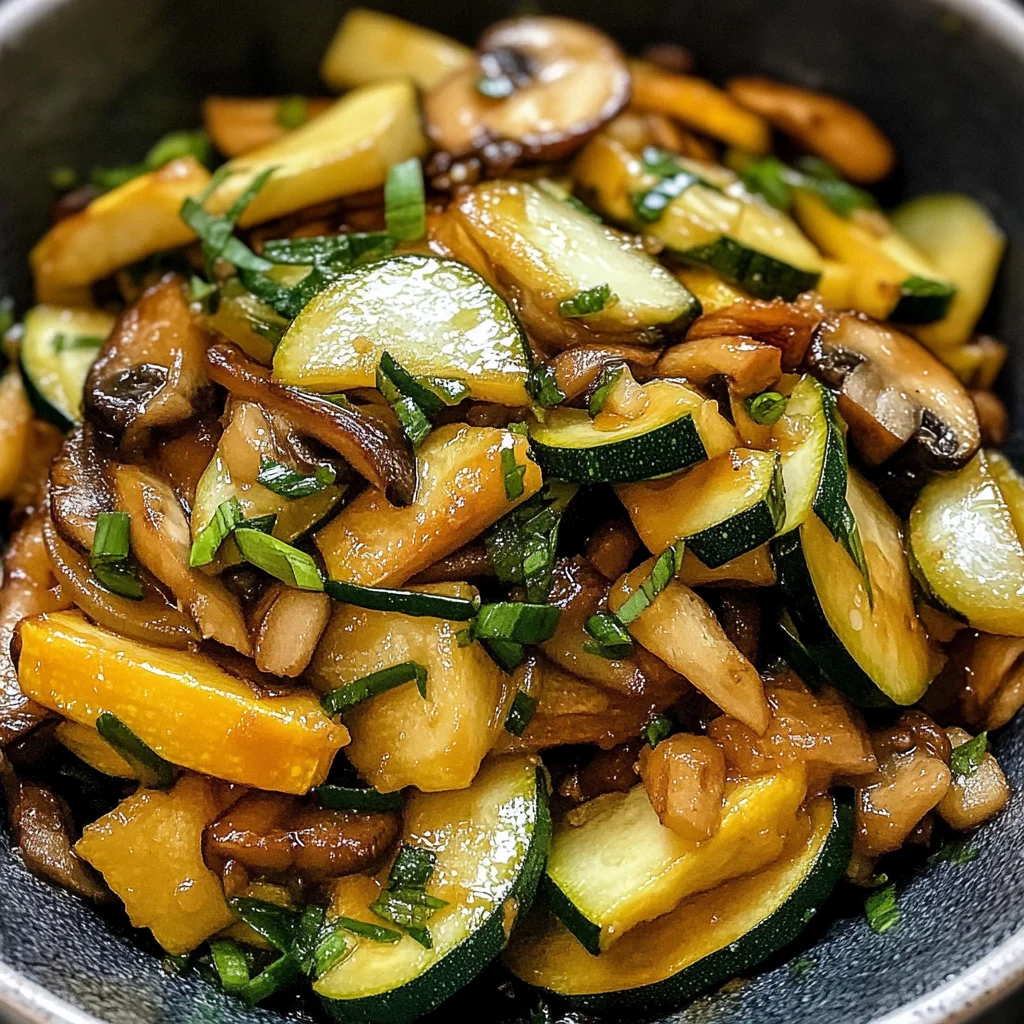Hibachi Vegetables are a delicious way to enjoy fresh veggies bursting with flavor. This recipe brings the taste of Japanese hibachi restaurants right into your kitchen. Perfect for family dinners or gatherings, these vibrant vegetables are easy to prepare and can complement any meal. You’ll love how simple ingredients transform into a colorful dish that’s both healthy and satisfying.
Why You’ll Love This Recipe
- Quick and Easy: With just 30 minutes from prep to plate, this dish fits perfectly into busy weeknights.
- Fresh Ingredients: Featuring colorful zucchini, yellow squash, mushrooms, and onions, it’s a nutrient-packed side that’s as good for you as it is tasty.
- Versatile Pairing: Hibachi Vegetables go well with a variety of main dishes, making them an ideal side for any occasion.
- Flavorful Experience: A touch of soy sauce and sautéing creates a savory taste that enhances the freshness of the vegetables.
- Family-Friendly: This recipe is suitable for all ages—kids will enjoy the colorful presentation and delicious flavors!
Tools and Preparation
To create your Hibachi Vegetables efficiently, having the right tools is essential. These tools will help you achieve perfectly cooked vegetables with ease.
Essential Tools and Equipment
- Wok or large skillet
- Cutting board
- Knife
- Measuring spoons
- Spatula
Importance of Each Tool
- Wok or large skillet: Ideal for high-heat cooking, allowing you to stir-fry the vegetables quickly while retaining their crunch.
- Knife: A sharp knife ensures clean cuts for even cooking, enhancing both presentation and texture.
- Spatula: A sturdy spatula helps in tossing the vegetables evenly without damaging them.

Ingredients
Hibachi Vegetables are made with fresh yellow squash, zucchini, mushrooms, and onions. It is the same Japanese style restaurant version in the comfort of your own home.
For the Base
- 1 tablespoon butter
- 2 tablespoons vegetable oil or olive oil
For the Vegetables
- 1 cup onion, quartered and thinly sliced
- 2 cups zucchini, cut into strips
- 2 cups yellow squash, cut into strips
- 1 cup mushrooms, sliced
For Seasoning
- 2 teaspoons soy sauce
- 1/4 teaspoon salt
- 1/4 teaspoon ground black pepper
How to Make Hibachi Vegetables
Step 1: Heat the Pan
Begin by heating your wok or large skillet over medium-high heat. Add in the 1 tablespoon of butter. Once it melts, pour in 2 tablespoons of oil.
Step 2: Sauté Onions
Add the 1 cup of sliced onion to the pan. Sauté for about 2 minutes until it softens and turns translucent.
Step 3: Add Remaining Vegetables
Next, incorporate 2 cups of zucchini, 2 cups of yellow squash, and 1 cup of mushrooms into the pan.
Step 4: Season Your Dish
Add in 2 teaspoons of soy sauce, along with 1/4 teaspoon salt and 1/4 teaspoon ground black pepper. Stir frequently until the vegetables reach your desired tenderness; this should take around 10 minutes.
Step 5: Serve and Enjoy
Serve your Hibachi Vegetables warm alongside hibachi-style fried rice and yum yum sauce. Any leftovers can be stored in an airtight container in the refrigerator for up to three days.
How to Serve Hibachi Vegetables
Hibachi Vegetables make a delightful side dish that can complement various meals. Here are some creative serving ideas to elevate your dining experience.
Pair with Fried Rice
- Serve your hibachi vegetables alongside fried rice for a classic combination. The flavors meld beautifully, making it a satisfying meal option.
Add to Grilled Meats
- These vegetables work well with grilled chicken, beef, or lamb. Their subtle flavor enhances the richness of the meat.
Top with Yum Yum Sauce
- Drizzle yum yum sauce over your hibachi vegetables for an extra layer of creaminess and flavor. This popular condiment adds a sweet and tangy touch.
Serve in Lettuce Wraps
- For a fresh twist, spoon hibachi vegetables into lettuce leaves. This makes for a light and healthy appetizer or snack.
Accompany with Sushi Rolls
- Enjoy your hibachi vegetables as a side to sushi rolls. The crunchiness complements the soft texture of sushi perfectly.
How to Perfect Hibachi Vegetables
For the best results when making hibachi vegetables, consider these tips to enhance their flavor and texture.
- Choose Fresh Ingredients: Use fresh zucchini, yellow squash, mushrooms, and onions for optimal taste and crunch.
- Maintain High Heat: Cooking at medium-high heat allows the vegetables to sear nicely while retaining their natural moisture.
- Stir Frequently: Keep stirring the veggies while cooking to ensure even cooking and prevent burning.
- Adjust Seasoning: Feel free to tweak the soy sauce and seasoning amounts based on your taste preferences for a personalized touch.
- Cut Evenly: Cut all vegetables into similar sizes for uniform cooking, ensuring they soften at the same rate.
Best Side Dishes for Hibachi Vegetables
Hibachi Vegetables pair well with various side dishes that can enhance your meal. Here are some delicious options:
- Fried Rice: A staple in hibachi cuisine, this dish is often cooked with eggs and green onions for added flavor.
- Grilled Chicken Skewers: Tender chicken skewers seasoned with spices make a hearty addition that complements the veggies.
- Cucumber Salad: A refreshing salad made with sliced cucumbers tossed in vinegar provides a cool contrast to warm dishes.
- Steamed Edamame: Lightly salted edamame is a nutritious snack that pairs well with any Japanese-inspired meal.
- Tempura Vegetables: Crispy tempura vegetables add texture and variety to your plate, enhancing both presentation and flavor.
- Miso Soup: A warm bowl of miso soup serves as a comforting starter that balances out the meal’s richness.
- Sushi Rolls: Assorted sushi rolls add exciting flavors and textures that pair wonderfully with hibachi vegetables.
- Teriyaki Chicken Wings: Sticky teriyaki wings offer a sweet-savory kick that complements the lighter flavors of hibachi veggies.
Common Mistakes to Avoid
When preparing Hibachi Vegetables, it’s easy to make some common mistakes. Here are a few tips to ensure your dish turns out perfectly.
- Skipping the Prepping Step: Not chopping vegetables uniformly can lead to uneven cooking. Make sure all veggies are cut into similar sizes for even heat distribution.
- Overcrowding the Pan: Adding too many vegetables at once can steam them instead of sautéing. Cook in batches if necessary to achieve that perfect caramelization.
- Neglecting Oil Temperature: Using oil that isn’t hot enough will result in soggy veggies. Ensure your oil is shimmering before adding the vegetables for a great sear.
- Ignoring Seasoning: Failing to season properly can lead to bland vegetables. Taste and adjust seasoning throughout cooking for the best flavor.
- Not Cooking to Preference: Overcooking or undercooking can ruin the dish. Keep an eye on the texture you prefer and remove from heat accordingly.

Storage & Reheating Instructions
Refrigerator Storage
- Store leftovers in an airtight container.
- Keep in the refrigerator for up to 3 days.
Freezing Hibachi Vegetables
- Place in freezer-safe bags or containers.
- They can be frozen for up to 2 months.
Reheating Hibachi Vegetables
- Oven: Preheat to 350°F (175°C) and bake for about 10-15 minutes until heated through.
- Microwave: Heat on medium power for 2-3 minutes, stirring halfway through for even warmth.
- Stovetop: Sauté over medium heat with a splash of water or oil until warmed through.
Frequently Asked Questions
Here are some common questions about Hibachi Vegetables that may help you prepare your dish perfectly.
How do I make Hibachi Vegetables more flavorful?
Adding garlic or ginger can enhance the flavor of your Hibachi Vegetables significantly. You can also experiment with different sauces or spices.
Can I use other vegetables in my Hibachi mix?
Absolutely! Feel free to include bell peppers, broccoli, or asparagus based on your preferences. Just ensure they cook evenly with the others.
What should I serve with Hibachi Vegetables?
Hibachi Vegetables pair wonderfully with fried rice, grilled chicken, or tofu dishes. They also complement salads nicely.
How do I store leftover Hibachi Vegetables?
Store any leftovers in an airtight container in the refrigerator for up to three days, or freeze them for longer storage.
Final Thoughts
Hibachi Vegetables are not only delicious but also versatile, making them a great addition to various meals. You can easily customize this recipe by adding your favorite vegetables or adjusting seasoning levels. Give it a try and enjoy this delightful dish at home!
Hibachi Vegetables
Hibachi Vegetables are a vibrant and flavorful side dish that brings the essence of Japanese cuisine right to your kitchen. This quick and easy recipe highlights fresh ingredients like zucchini, yellow squash, mushrooms, and onions, all sautéed to perfection with a touch of soy sauce. Ideal for busy weeknights or festive gatherings, these colorful veggies serve as a delightful complement to grilled meats or fried rice. Enjoy the savory taste and health benefits of this nutrient-packed dish that’s sure to please everyone at the table.
- Prep Time: 10 minutes
- Cook Time: 10 minutes
- Total Time: 20 minutes
- Yield: Serves 4
- Category: Side Dish
- Method: Sautéing
- Cuisine: Japanese
Ingredients
- 1 tablespoon butter
- 2 tablespoons vegetable oil or olive oil
- 1 cup onion, quartered and thinly sliced
- 2 cups zucchini, cut into strips
- 2 cups yellow squash, cut into strips
- 1 cup mushrooms, sliced
- 2 teaspoons soy sauce
- 1/4 teaspoon salt
- 1/4 teaspoon ground black pepper
Instructions
- Heat a wok or large skillet over medium-high heat and add butter. Once melted, pour in the oil.
- Sauté the sliced onion for about 2 minutes until soft and translucent.
- Add zucchini, yellow squash, and mushrooms to the pan.
- Season with soy sauce, salt, and pepper. Stir frequently until vegetables are tender (about 10 minutes).
- Serve warm alongside your favorite main dishes.
Nutrition
- Serving Size: 1 serving
- Calories: 100
- Sugar: 3g
- Sodium: 300mg
- Fat: 7g
- Saturated Fat: 2g
- Unsaturated Fat: 5g
- Trans Fat: 0g
- Carbohydrates: 10g
- Fiber: 3g
- Protein: 2g
- Cholesterol: 5mg





Leave a Comment